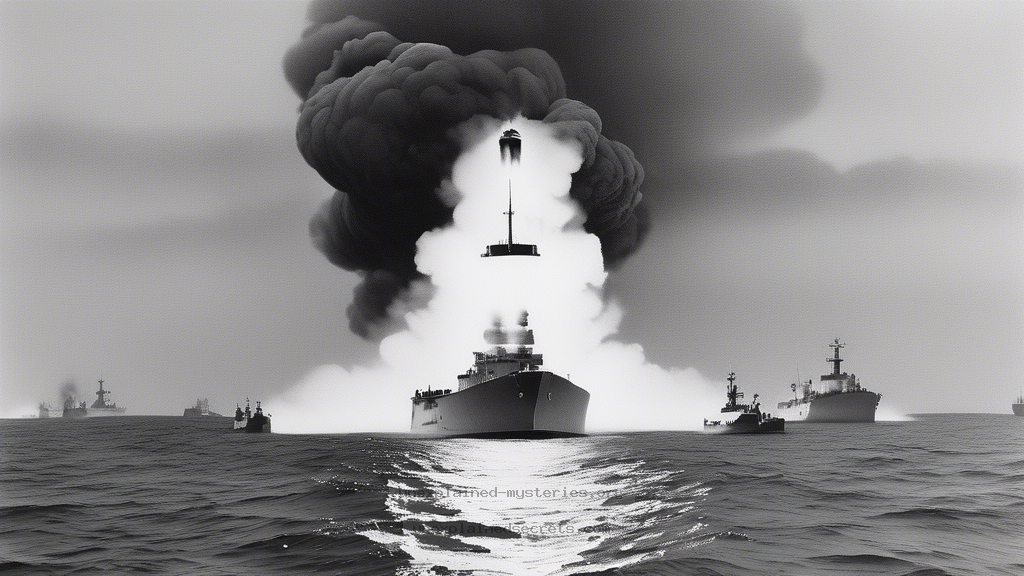What Really Happened During the Philadelphia Experiment: A Government Cover-Up or a Military Science Failure?
What Really Happened During the Philadelphia Experiment: A Government Cover-Up or a Military Science Failure?
The Philadelphia Experiment remains one of the most captivating and controversial mysteries in conspiracy theory history. This alleged military experiment in 1943 purportedly involved the U.S. Navy’s USS Eldridge, which, according to various accounts, was rendered invisible to radar and even teleported from Philadelphia to Norfolk, Virginia, and back. The question of what truly transpired during this event raises profound implications about government secrecy, military experimentation, and the boundaries of scientific understanding. Why does this matter? Because it not only challenges our perceptions of reality but also highlights the potential for cover-ups and misinformation in government actions, shaping how we view military and scientific advancements today. Let’s dive deeper into this enigma.
Historical Context of the Philadelphia Experiment
The Philadelphia Experiment is said to have occurred during World War II, a time when the U.S. military was intensely focused on technological advancements to gain an advantage over Axis powers. The story began circulating in the 1950s, fueled by the writings of individuals like Carlos Allende, who claimed to have witnessed the experiment while aboard a nearby ship. According to Allende, the Eldridge underwent a series of tests that resulted in extreme and bizarre outcomes, including crew members becoming “fused” to the ship. This narrative quickly caught the imagination of the public and conspiracy theorists alike, leading to various interpretations and fabrications over the years.
Core Concepts and Theories Surrounding the Experiment
At the heart of the Philadelphia Experiment are several key theories that have emerged over time:
- Electromagnetic Field Manipulation: Some theorists suggest that the Navy was experimenting with electromagnetic fields, attempting to create a cloaking effect on ships.
- Time Travel: Other accounts posit that the experiment may have unintentionally opened a gateway to time travel, leading to the ship’s alleged teleportation.
- Government Cover-Up: The most pervasive theory is that the government engaged in a cover-up to keep the public from knowing the true extent of the experiment’s consequences.
Documented Evidence and Practical Implications
While much of the evidence surrounding the Philadelphia Experiment is anecdotal, some documents have emerged that lend a semblance of credibility to the claims. For instance, the U.S. Navy’s declassification of some documents related to the experiment has sparked debates about their authenticity and the extent of military experimentation during the war.
Key Document: In 1983, a document known as the “Rohwer Report” was released, which discussed various naval tactics and technologies. Proponents of the Philadelphia Experiment argue that this document hints at secretive military projects similar to what Allende described.
This suggests that while there may not be direct evidence of the experiment as described in popular lore, the Navy’s willingness to conduct secret research into advanced technologies is well-documented. It raises essential questions about the ethical implications of such research and its potential impacts on human life.
Alternative Perspectives on the Philadelphia Experiment
There are several alternative viewpoints regarding the Philadelphia Experiment that merit consideration:
- Skeptical View: Many critics argue that the entire narrative is based on myth and urban legend, fueled by the Cold War paranoia and a fascination with conspiracy theories.
- Psychological Effects: Some psychologists propose that Allende and others who reported on the experiment may have experienced psychological phenomena such as false memories or delusions.
These perspectives challenge the mainstream narrative and prompt a critical analysis of how collective memory and societal fears can shape historical events.
Common Misconceptions and Clarifications
Despite the allure of the Philadelphia Experiment, several misconceptions persist:
- Misconception 1: The experiment was officially recognized by the U.S. Navy.
Clarification: The Navy has consistently denied the existence of such an experiment. - Misconception 2: The ship was made completely invisible.
Clarification: Reports vary, with some claiming it was only invisible to radar, not visually.
Notable Fact: The term “Philadelphia Experiment” was not used until the 1950s, long after the alleged events took place, indicating a possible fabrication of narratives over time.
Best Practices for Investigating Similar Conspiracy Theories
When delving into conspiracy theories like the Philadelphia Experiment, consider the following best practices:
- Source Verification: Always check the credibility of sources; primary documents are more reliable than hearsay.
- Contextual Understanding: Understand the historical and social context in which these theories arise.
- Critical Thinking: Apply critical thinking skills to differentiate between plausible theories and sensationalist accounts.
By employing these techniques, researchers can navigate the murky waters of conspiracy theories more effectively, distinguishing between fact and fiction.
Future Developments and Ongoing Research
The fascination with the Philadelphia Experiment continues to inspire books, documentaries, and online discussions. Researchers are exploring the implications of military secrecy in modern times, particularly with advancements in technology that could render past experiments obsolete. The ethical considerations of such research will likely remain a heated topic, especially as we enter an era where artificial intelligence and advanced weaponry become commonplace.
Future Insight: With renewed interest in government accountability and transparency, there may be additional disclosures that could shed light on past military experiments, including those similar to the Philadelphia Experiment.
Conclusion: Unraveling the Mystery of the Philadelphia Experiment
The Philadelphia Experiment exemplifies the intersection of conspiracy, military secrecy, and scientific inquiry. While the veracity of the experiment remains contested, its enduring legacy prompts critical questions about government transparency and the ethical boundaries of scientific exploration. As we continue to uncover the layers of this mystery, it serves as a reminder that not all truths are easily discernible, and sometimes, the most compelling narratives are those shrouded in uncertainty.
In summary, the Philadelphia Experiment is a case study in how conspiracy theories can evolve, the implications of government actions, and the human propensity for storytelling in the face of the unknown. Whether viewed as a cautionary tale or an invitation to explore, it remains an intriguing chapter in the annals of conspiracy theory lore.
Other Articles
Recent Posts
- What Happened to Flight MH370? The Conspiracy Theories That Still Haunt Us
- What Secrets Lurk Within the Walls of the Infamous Trans-Allegheny Lunatic Asylum?
- What Evidence Supports the Existence of Bigfoot in the Pacific Northwest?
- What Happened to the Indus Valley Civilization? Unraveling the Mysteries of Ancient Urban Life
- Can Telepathy Be Scientifically Proven Through Laboratory Evidence?







